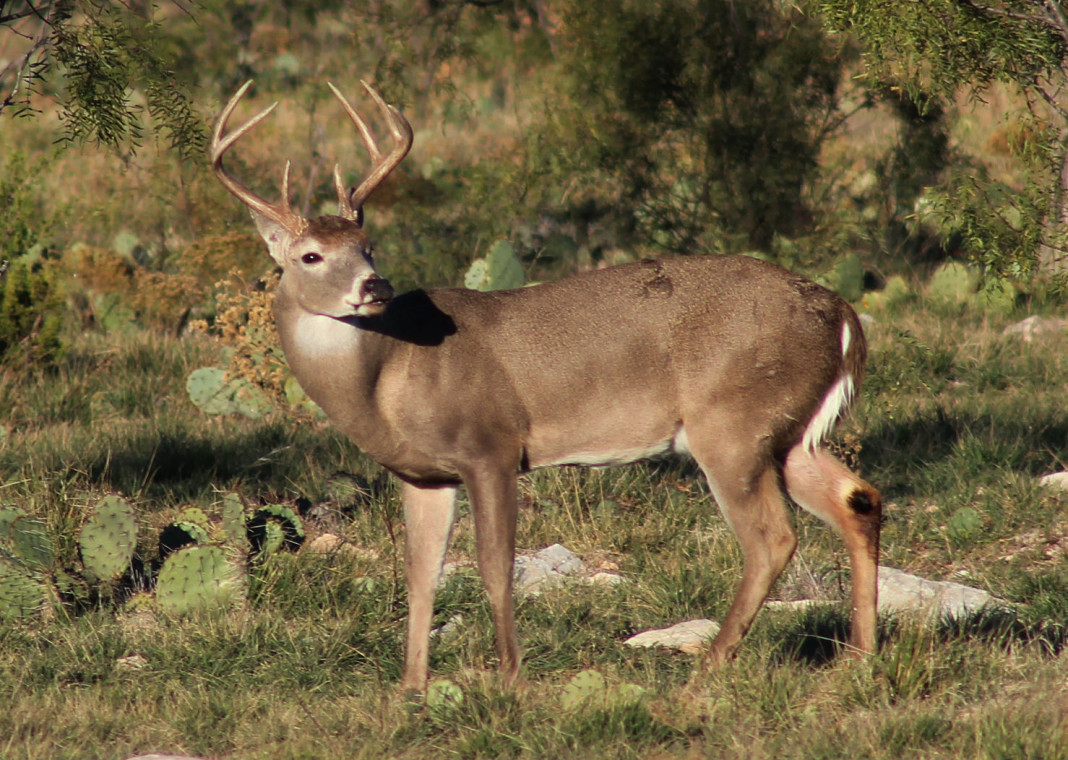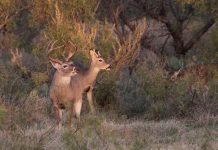Without a doubt, Texas is blessed with the best hunting opportunities in the country.
We’ve got the largest white-tailed deer herd in the nation – numbering roughly 4 million in moisture-rich years – and our bird hunting ranging from ducks, geese and doves to pheasants, sandhill cranes and quail offers fanstastic wingshooting from September through February from the Panhandle to the brush country of South Texas.
However, if there is a downside to hunting in the Lone Star State, it relates to access, with roughly 97 percent of lands resting in private hands. That being said, it’s hard to overlook public hunting locales in Texas – with nearly a million acres of territory accessible to anyone who buys a hunting license and a permit – and those areas hold a lot of game, too.
Since 1987 the Texas Parks & Wildlife Department’s annual public hunting permit program has helped hunters across the state partake in less expensive outings for wildlife including deer and birds to hogs and exotics. The program includes hundreds of thousands of acres situated across the state, with many good hunts not far from urban centers. And if you’re looking to get far away from civilization, there are plenty of options as well.
A valid hunting license and any necessary stamp endorsements are required to participate on public hunts, but the overall costs are much more reasonable than regular lease fees, and are a great way to introduce youngsters to the pursuits.
Justin Dreibelbis, Private Lands & Public Hunting Program Director with TPWD, said that hunting has become much more competitive in recent decades. In some cases, hunters are being priced right out of areas they previously hunted.
“It is getting harder and harder to find an affordable place to hunt in a private lands state like Texas,” Dreibelbis said. “Hunters pay for wildlife conservation in this country and we, as a state game and fish agency, have an obligation to provide as many high-quality public hunting opportunities as we can so that they can enjoy these areas with friends and family and pass their conservation values on to the next generation of hunters.
“TPWD has offered drawn hunting opportunities on wildlife management areas and state parks for years and with our new online system, it is easier than ever to take part in the program. This year we will draw nearly 5,000 special permits for a diverse group of hunts for species including everything from alligators on the Gulf Coast to desert bighorn sheep in the Trans-Pecos. Included in these drawings are eight youth-only hunt categories. Applications for these special permit hunts are only $3 per hunt and free for youth.”
In addition, the annual public hunting permit, which costs only $48, offers access to nearly 200 hunting areas, including large tracts located in wildlife management areas, and more than 100 dove and small-game areas leased from private landowners. In addition to regular hunts, there also are youth-only and youth-adult hunts for deer, waterfowl, doves, rabbits, squirrels and feral hogs, and youths 16 and younger may access the public hunt areas free of charge when accompanied by a permitted adult.
Another public-hunting angle is regular permit hunts, available for certain small-game and waterfowl excursions. The regular permits are issued at hunt areas on a first-come, first-serve basis, with a $20 fee charged for each one issued. However, the fees are waived for hunters 16 and younger when hunting under the supervision of an authorized adult who possesses a regular permit or an annual hunting permit.
One opportunity targeted specifically at introducing novices is mentored hunting, with workshops at select state parks and wildlife management areas. Mentored hunting permits – which cost $25 – are required for these workshops and are offered on a first-come, first-serve basis. The permits are valid for a specific public hunting unit and corresponding workshop dates, but they are great for introducing and educating beginning hunters and their mentors. The workshops are followed by a hunt on the specific area for doves, waterfowl or deer.
Among the largest ways that TPWD attempts to provide hunting opportunities to the public is through its annual online-only drawings for everything from deer and antelope to turkeys and alligators. Thousands of hunters are chosen through random drawings for hunts, including those on wildlife management areas, state parks and private ranches, and with application fees ranging from $3 to $10, these are a bargain. The drawn hunt permit fees if you are chosen range from $80 (standard two- to three-day hunt) to $130 (extended four- to five-day hunt), but when you consider you could pay more than 20 times that much just to lease some decent land for one gun, the value shines through. It also should be noted that youths between the ages of 8 and 16 may apply and hunt without paying an application or permit fee.
Among the hunts included on the online-only drawing system are three guided packages for bighorn sheep, gemsbok and scimitar-horned oryx that include food, lodging and on-site transportation.
In addition to the regular drawn hunts, TPWD offers e-postcard selection hunts for a limited number of opportunities on select hunt areas that do not require application or special permit fees. Adults selected for these hunts are required to purchase an annual public hunting permit.
Complete descriptions of the hunts offered, hunt areas, application instructions and the applications themselves can be found on TPWD’s website. In addition to providing statistics on how many hunters applied for a specific hunt or area, the agency regularly includes the prior season’s harvest success rates for a specific hunt area. Major deadlines are early August for alligator and archery deer; September for gun deer and youth deer; and October for exotics, feral hog, javelina and spring turkey. The drawings are posted online well in advance of the deadlines, offering plenty of time to research and decide the best bang for your buck.
Another hunt drawing is the Big Time Texas Hunts program, a raffle in which hunters can buy as many chances as they would like for a chance at nine different all-inclusive, fully-guided hunting packages on Wildlife Management Areas and private lands.
“The program (featuring $10 entries) is essentially a conservation fundraiser with proceeds going directly back into wildlife habitat, research and public hunting projects,” Dreibelbis said.
Hunter Education is mandatory on public hunts and every adult hunter born on or after Sept. 2, 1971, must successfully complete a hunter education training course. The minimum age of certification is 9 and the cost is $15. A one-time hunter education deferral ($10) allows a person 17 or older who has not completed a hunter education program to defer completion for as long as a year. A deferral may only be obtained once and is only valid until the end of the current license year.
It should be noted that certification is not required to purchase a hunting license in Texas.
Another mandatory requirement on most public hunts is the use of hunter orange clothing. The standard, according to TPWD, is having “visible at least 400 square inches of hunter orange material with orange headware and at least 144 square inches appearing on both chest and back during daylight hours at times when hunting with firearms is permitted.” Exemptions to the regulations include persons hunting turkey or migratory birds, persons within the enclosed passenger compartment of a motor vehicle or persons within designated campgrounds, vehicle parking area or departmental check stations.
Notable Texas public hunting areas
If you’re looking for some of the best hunting country in Texas, you need venture no further than these three locales situated in various corners of the state:
Chaparral Wildlife Management Area
The “Chap” is a deer-hunting hot spot situated just southwest of Cotulla, but its 15,000 acres include great hunts for birds and other game, too. All deer, javelina and feral hog hunts are by drawing only, but the WMA offers public hunt access for white-winged doves and mourning doves, and quail. This area typically has the highest number of entrants vying for hunting spots, but its reputation as a game-rich area makes it worth paying the entry fee.
Matador Wildlife Management Area
This 28,000-acre area southwest of Childress near the Oklahoma border is well-known for its deer opportunities and annually produces multiple whitetail bucks exceeding 150 Boone & Crockett points and mule deer surpassing 160 B & C for public hunters. The area also offers excellent turkey hunting, especially in years with average to good rainfall, and hunters annually find similary good shoots for doves, quail and early teal.
Pat Mayse Wildlife Management Area
It’s tough to beat the variety of game this 8,000-acre area north of Paris offers, and hunters can pursue deer, ducks, geese, doves, hogs, furbearers and even bullfrogs. The WMA includes wraps around Pat Mayse Lake, which itself is a noted fishery for bass, catfish and crappie for much of the year. The waterfowl hunting alone is worth the price of admission and this is wood duck and canvasback country more than anyplace else in the state, and the region also boasts impressive numbers of other dabbling ducks and teal, too.
Texas Parks & Wildlife also offers a comprehensive public hunting guide.



















